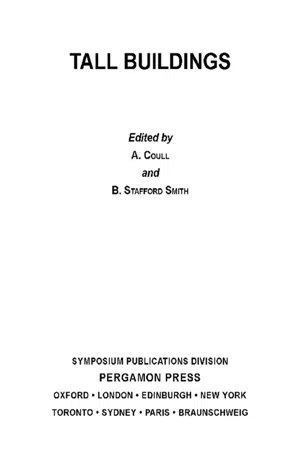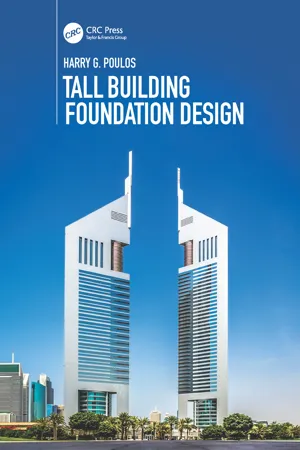Empire State Building
The Empire State Building is a famous skyscraper located in New York City. It was completed in 1931 and was the tallest building in the world until 1970. Known for its Art Deco design and innovative construction techniques, the building is an iconic symbol of American engineering and architecture.
5 Key excerpts on "Empire State Building"
- eBook - ePub
Designing Tall Buildings
Structure as Architecture
- Mark Sarkisian(Author)
- 2016(Publication Date)
- Routledge(Publisher)
...The fully enclosed building, including the mooring mast that raised its height to the equivalent of 102 stories, was finished by March 1931 (11 months after the first steel column was placed). The opening day ceremony took place on May 1, 1931. The structural engineer, H.G. Balcom (from a background in steel fabrication and railroad construction), worked closely with general contractors Starrett Brothers and Eken to devise a systemized construction process. Three thousand five hundred workers were on-site during peak activity. Some 52,145 metric tonnes (57,480 tons) of steel, 52,145 cubic meters (62,000 cubic yards) of concrete, 10 million bricks, 6,400 windows, and 67 elevators were installed. The Empire State Building remained the tallest building in the world for 41 years until the World Trade Center in New York was built in 1972. The Chrysler, Empire State, and World Trade Center Buildings were all constructed of structural steel. Beaux Arts Architect Ball (1931), New York, NY Empire State Building, RCA Building in Rockefeller Center, Chrysler Building, Skyscrapers of New York linen postcard (1943) Moment Distribution for Indeterminate Structures The development of more sophisticated hand calculation techniques for structures, including methods developed by great engineers like Hardy Cross, allowed engineers to analyze, design, and draw structures that could be easily constructed. Urged by the University of Illinois’ Dean of Engineering Milo Ketchum, Cross published a ten-page paper titled “Analysis of Continuous Frames by Distributing Fixed-End Moments” in 1930, showing how to solve force distribution in indeterminate structures, which was one of the most difficult problems in structural analysis. World War II temporarily halted homeland construction because of the need for steel products in the war efforts. It wasn’t until the late 1950s and early 1960s that interest in tall buildings was renewed...
- eBook - ePub
- Deborah K. Dietsch(Author)
- 2011(Publication Date)
- For Dummies(Publisher)
...An observation space, a private men’s dining room and gym called the Cloud Club, and a duplex apartment for Walter Chrysler were all located just below the spire. On the ground floor, the triangular lobby was finished in colored marbles and onyx, an ornate ceiling mural, and dramatic lighting. All the building’s elevators were lined in different patterns of exotic wood paneling. Although it was derided by a critic for its “inane romanticism,” the Chrysler Building — with its quirky spire — has become one of the most beloved skyscrapers in the world. Empire State Building: New York’s Highest In 1931, only months after the completion of the Chrysler Building, the title for the world’s tallest building was claimed by an even higher structure, the Empire State Building. At 1,250 feet high, it surpassed the Chrysler Building by 204 feet and broke every previous construction record. The base of the Empire State Building covers 2 acres, and its 85 floors contain 2.1 million square feet of offices. Its construction required 60,000 tons of steel, 200,000 cubic feet of Indiana limestone and granite, 10 million bricks, 730 tons of aluminum and stainless steel, 70 miles of water pipes, 2,500 toilets and sinks, and more than 3 million light bulbs. Despite its staggering size, the Empire State Building was planned and built with lightning speed. It took just 20 months from the time the contracts were signed with the architecture firm Shreve, Lamb and Harmon until construction was completed and the first tenants moved into the building in April 1931. Because of the Depression, however, it was difficult to rent office space, so the skyscraper was nicknamed the “Empty State Building.” In 1945, a plane crashed into the 79th floor of the Empire State Building, but the building suffered only minor damage...
- eBook - ePub
Tall Buildings
The Proceedings of a Symposium on Tall Buildings with Particular Reference to Shear Wall Structures, Held in the Department of Civil Engineering, University of Southampton, April 1966
- A. Coull, B. Stafford Smith(Authors)
- 2014(Publication Date)
- Pergamon(Publisher)
...It seems to me that the dividing line should be drawn where the design of the structure moves from the field of statics into the field of structural dynamics. My remarks, then, will be organized about buildings in the latter category and will, for the most part, consider steel framed structures. In Fig. 1 is a photograph of the Empire State Building. The photograph, taken from 34th Street, tells a story of vertical scale that must compel respect and admiration from us all. Any engineer who feels that the design and construction of such a building is easy has obviously never been responsible for the design of a major building. The problems involved are exceedingly complex; the analysis of the structure is the easiest part of the whole. FIG. 1 The first of our criteria, speed of construction, is our most serious problem. The designer’s programme for the Empire State Building was short and simple—a fixed budget, no space more than 28 feet from window to corridor, as many stories of such space as possible, an exterior of limestone and, here is the astonishing part, completion by May 1, 1931, which meant a year and six months from the beginning of the architect’s sketches to the finished and occupied building. The distribution of light, power and communication services, water, and particularly heat and air is infinitely more complex in today’s modern structures than was even dreamed during the design stages of the Empire State Building. As such, the designers of today would have great difficulty completing their work within that 18 month period much less accomplishing the construction as well. The structural steel work at the site began in April of 1930 and ended in September of that same year, a period of less than six months. 57,000 tons of structural steel were placed. During the month of July, 22 stories of steel were placed in 22 working days, involving regular hours and no night work. The steel work was finished 12 days ahead of schedule...
- eBook - ePub
Tall Buildings
Structural Systems and Aerodynamic Form
- Mehmet Günel, Hüseyin Ilgin(Authors)
- 2014(Publication Date)
- Routledge(Publisher)
...Compared with a building with load-bearing masonry walls and the same number of storeys, the metal skeleton was three times lighter and the exterior walls were designed only to protect the building from adverse weather conditions and not to provide structural support. It was recognised as having many more and larger window openings in its facade than other buildings of its era. With the commencement of the use of non-structural perimeter and partition elements in tall buildings instead of thick masonry load-bearing walls, thanks to the appearance of the Home Insurance Building and the frame system, the architectural and financial value of the spaces within buildings was increased and more usable space and natural light was obtained in the interior. Thus, just as this development made the construction of tall buildings much more practical, it also increased their utility. Bibliography Bennett, D., Skyscrapers: Form & Function, Simon & Schuster Ltd., New York, 1995. Harbert, L., Home Insurance Building – The First Skyscraper, Journal of American Society of Civil Engineers (ASCE), Vol. 43, No. 2, pp. 1–2, 2002. Home Insurance Building, http://www.ctbuh.org, accessed May 2012. Home Insurance Building, http://www.emporis.com, accessed May 2012. Empire State Building OFFICIAL NAME : Empire State Building LOCATION : New York, USA BUILDING FUNCTION : Office ARHITECTURAL HEIGHT : 381 m NUMBER OF STOREYS : 102 STATUS : Completed COMPLETION : 1931 ARCHITECT : Shreve Lamb & Harmon Associates STRUCTURAL ENGINEER : H.G. Balcom & Associates; Post and McCord; Strong & Jones Engineers STRUCTURAL SYSTEM : Shear trussed frame system/steel (courtesy of Antony Wood/CTBUH) Empire State Building: architectural and structural information The 102-storey, 381 m high Empire State Building in New York (USA) was designed by Shreve Lamb & Harmon Associates. It is a steel building with a shear trussed frame system...
- eBook - ePub
- Harry G. Poulos(Author)
- 2017(Publication Date)
- CRC Press(Publisher)
...Early tall buildings were constructed using load bearing walls, but with the advent of structural steel, tall buildings emerged in such cities as New York, Philadelphia and London. From the end of the nineteenth century until the latter part of the twentieth century, New York took the lead in the construction of tall buildings, and held the world record for building height, first with the Chrysler building, then the Empire State Building and then the World Trade Center towers. In 1974, the Sears Tower in Chicago took over the mantle until 1998, when the title of tallest building moved to Kuala Lumpur Malaysia, with the completion of the Petronas Towers. Subsequently, this has been taken over by Taipei, and then in 2010 by Dubai. Tall buildings have become a worldwide phenomenon over the past three decades, but with particular concentrations in Asia and the Middle East. Table 1.1 summarises the tallest modern buildings in the world, starting in 1885, based on the data of Parker and Wood (2013). Table 1.1 Tallest buildings since 1885 Year Location Building Height (m) 1885 Chicago Home Insurance 55 1890 New York World 94 1894 New York Manhattan Life 106 1899 New York Park Row 119 1908 New York Singer 187 1909 New York Met Life 213 1913 New York Woolworth 241 1930 New York Bank of Manhattan 283 1930 New York Chrysler 319 1931 New York Empire State 381 1972 New York 1 World Trade. Center 417 1974 Chicago Sears 442 1998 Kuala Lumpur Petronas 1 & 2 452 2004 Taipei Taipei 101 508 2010 Dubai Burj Khalifa 828 Source: Based on Parker, D. and Wood, A. 2013. The Tall Buildings Reference Book...




